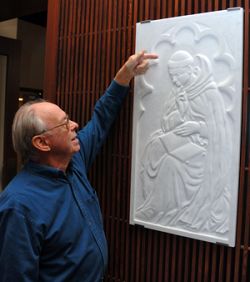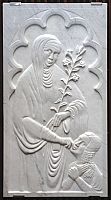Local artist shares talent with university parish

SALT LAKE CITY — For Ed Braak, one was more than enough. Hands cold and sore from working in the carport for more than a year on the same chunk of rock, Braak promised himself there would be no more of this. But the mind of an artist is a tricky thing. "After the unveiling of St. Catherine, I mentioned to him the other wall would be a great place for a St. Dominic," said Dominican Father Peter Rogers, pastor of St. Catherine of Siena Parish and Newman Center near the University of Utah. A year later, the artist was again suffering from sore, cold hands. On Aug. 8, the feast of St. Dominic, Braak’s latest relief was unveiled at St. Catherine Church. Across the principal door from the original St. Catherine relief, both sculptures in Carrara marble share a similar, complimentary design. In the fourteenth century, Andrea Vanni of Siena, Italy, frescoed the interior of the church of St. Dominic. A contemporary of St. Catherine of Siena, his painting of the saint provided the inspiration for Braak’s sculpture. Softening the face and other elements, Braak subtly brought the fresco into three dimensions. "When Catherine was finished, I didn’t know if Dominican Father Denis Riley (previous pastor of St. Catherine of Siena Parish) would like St. Catherine. I couldn’t get him to come to the house to see it until it was nearly finished. When he saw it, he said ‘Oh! I like it,’ and then he wanted to leave right away. He said later ‘I was so scared that it would look awful and would have to take it anyway," said Braak in an interview with the Intermountain Catholic. After Fr. Peter had made his remark about a St. Dominic relief, Braak began ruminating about the possibility of taking on the task again. "I just love to do this sort of stuff," he said. "I did some research and found a Fra Angelico fresco. Dominic is a very small part of the original. I decided I should put a framework similar to what was around St. Catherine, and that would make them more of a pair. I began working on that, and it took another year of work." Braak’s inspiration for the St. Dominic relief came from Blessed Fra Angelico Giovanni da Fiesole’s fresco of "The Mockery of Christ" in the convent of St. Mark in Florence, cell seven. In this work, St. Dominic is a diminutive figure in the lower right. Entirely self taught, Braak keeps detailed records of all his work in a well-worn notebook, yellowing at the edges. "I try things and then I record them in my notebook. When I first wanted to start doing sculpture, I wanted to take lessons, but there was nobody who would teach me in Utah. So I read a couple books and got a chunk of granite from the mountain and started banging away on it." Braak began both sculptures in clay models after researching the subjects extensively and sketching cartoons of his designs. Satisfied with the models, he photocopied them and measured the inset depth from the top, making a detailed topography with thousands of measurements. Approaching the marble, however, is another matter. According to Braak, "It cuts easily, it’s not that hard, it polishes nicely, it’s fairly easily available." St. Catherine’s size, 19 inches by 36 inches, was determined by the largest piece of stone he could cut from the slab available. For St. Dominic, he had his supplier cut it for him. Once he began cutting, the work was slow. "I have a diamond blade that cuts aggressively, and use it to take out any of the deep areas. It looks awful. Then I have a high speed drill tool and use carbide bits. Then many smaller sizes, for smaller details. Finer details like eyes, hair, and flowers are done with dental burrs. They can only be used once; my dentist is nice and he saves them for me. Finally comes the polishing, the hardest part. I Start out with a 60 grit sandpaper, and I also have a very small belt sander but it only works if I’m very gentle with it. I sand until my fingers are too sore to do anything more. And then I say, ‘that’s it.’ I’m done." Together with his wife Barbara, a painter, the Braaks create art in acrylic paints, watercolors, and pastels, as well as granite, quartz, alabaster, honeycomb calcite, marble, and wood. According to Ed, "We don’t compete. I don’t paint and she doesn’t sculpt. We get along. We criticize each other." Barbara quickly added, "and we’re pretty tough." For those who look closely at the relief of St. Dominic, the subtlety of the work will offer a few details. The veins on St. Dominic’s left hand are modeled after the artist’s. A halo can be seen at just the right angle, the carefully polished stone reflecting the light. Above St. Dominic’s head, a star reminds the viewer of one of the stories of about the 12th century saint. According to Braak, "a nun wrote that when he was teaching them, they observed a bright shining star in the middle of his forehead." Dominican Brother Michael Augustine Amabisco of St. Catherine of Siena Parish thinks highly of Braak’s bas reliefs. "But we have a whole list of dominican saints! St. Thomas Aquinas, St Martin de Porres – he bi-locates so we’ll need three or four of him." Braak chuckled.
© Copyright 2024 The Diocese of Salt Lake City. All rights reserved.


Stay Connected With Us